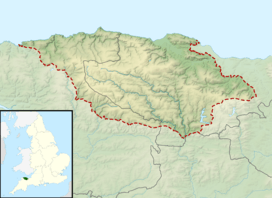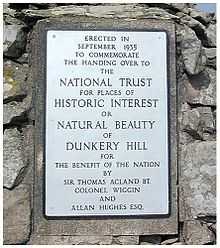Dunkery Hill
| Dunkery Hill | |
|---|---|
|
Dunkery Beacon seen on the ascent up the western slopes | |
| Elevation | 1,705 ft (520 m) |
| Prominence | 414 m (1,358 ft) |
| Parent peak | High Willhays |
| Listing | Marilyn, County Top |
| Location | |
 Dunkery Hill Exmoor, England | |
| OS grid | SS891415 |
| Coordinates | 51°09′43″N 3°35′14″W / 51.16197°N 3.58736°WCoordinates: 51°09′43″N 3°35′14″W / 51.16197°N 3.58736°W |
| Topo map | OS Landranger 181 |
Dunkery Beacon at the summit of Dunkery Hill is the highest point on Exmoor and in Somerset, England.
The sandstone hill rises to 1,705 feet (520 m) and provides views over the surrounding moorland, the Bristol Channel and hills up to 86 miles (138 km) away. The site has been visited by humans since the Bronze Age, and contains several burial mounds in the form of cairns and bowl barrows. Sweetworthy on the lower slopes is the site of two Iron Age hill forts or enclosures and a deserted medieval settlement. The hill is part of a Site of Special Scientific Interest and National nature reserve. It was in private ownership until 1935 when it was given to the National Trust by Sir Thomas Acland, Colonel Wiggin and Allan Hughes along with the rest of the Holnicote Estate. A stone cairn was erected at the summit to commemorate the event.
Location
Dunkery is composed of Middle Devonian sedimentary rock, (393.3± 2.7 million years ago) known as the Hangman Sandstone Formation.[1] This supports acidic soils.[2] The ridge along the top of the hill is 4.5 kilometres (2.8 mi) long.[3]
At 1,705 feet (520 m) ordnance datum (OD), the mean height above sea level,[4] Dunkery Beacon is the highest natural point in Somerset,[5] although the tip of the Mendip TV Mast is higher at 1,915 feet (584 m) OD. Dunkery is ranked 23rd in the UK in terms of dominance and is a Marilyn, meaning that it is a peak with 150 metres (490 ft) or more of relative height. The nearest higher hill is Yes Tor, 37 miles (60 km) away. One of the characters in R. D. Blackmore's 1869 novel Lorna Doone, John Fry, calls it the "haighest place of Hexmoor".[6]
Dunkery lies just four miles (6.4 km) from the Bristol Channel at Porlock. The shortest route of ascent goes from the car park at Dunkery Gate, and is just 0.75 miles (1.2 km) long. There are extensive views from the summit, including both the Bristol and English Channel coasts, the Brecon Beacons including Pen Y Fan, Bodmin Moor, Dartmoor, the Severn Bridges and Cleeve Hill 86 miles (138 km) away in Gloucestershire.[7]
History
There has been some debate about the origin of the name "Dunkery" and its predecessors "Duncrey" and "Dunnecray".[8] Eilert Ekwall suggests that it comes from the Welsh din meaning hillfort and creic or creag meaning rock.[9][10]
There are several Bronze Age burial mounds at or near the summit.[3][11] Two of the largest are Joaney How and Robin How, which have been damaged over many years, although plans have been made to restore and protect them.[12] "How" comes from the Norse for burial mound.[13] Joaney How on the northern slope, is more than 22 metres (72 ft) in diameter.[14][15] On the southeastern slopes are four more cairns.[16] There are a further two round cairns 390 metres (1,280 ft) and 420 metres (1,380 ft) southeast of Rex Stile Head.[17] In addition to the cairns are barrows which also date from the Bronze Age. One bowl barrow on the southeastern spur of the Chains is 12.3 metres (40 ft) in diameter.[18] A circular funerary stone mound 850 metres (2,790 ft) north of Dunkery Bridge, which is a 1.5 miles (2.4 km) walk from the summit dates from the Neolithic or Bronze Age. It is approximately 1.5 metres (4 ft 11 in) high and 14 metres (46 ft) in diameter.[19][20]

Sweetworthy, on Dunkery Hill's north-facing slope, is the site of two Iron Age hill forts or enclosures;[21][22] one has a single rampart and external ditch, enclosing 0.25 hectares (0.62 acres).[23] The rampart is still visible, and the ditch on the east side is used as a trackway.[24][25] There was a defended settlement above the main site.[26] It is also the site of a deserted medieval settlement, which has been designated an ancient monument.[27][28] It has been added to the Heritage at Risk register because of the vulnerability to plant growth.[29]
The hill was part of the "Royal Forest of Exmoor" established by Henry II according to the late 13th-century Hundred Rolls.
In 1928 Dunkery Hill was put up for sale. Labour Party activist and member of parliament Margaret Bondfield asked in the House of Commons if the government was willing to have it designated an ancient monument, to preserve it for future generations. She received the reply that although the government was agreeable to having the hill listed there were no funds available for its purchase,[30] the beacon and surrounding mounds were subsequently designated an ancient monument.[31] Dunkery Hill was given to the National Trust in 1935 by Sir Thomas Acland, Colonel Wiggin and Allan Hughes along with the rest of the Holnicote Estate an event commemorated by the summit memorial cairn.[32][33][34]
Ecology
The site is part of the North Exmoor Site of Special Scientific Interest (SSSI), is part of the Dunkery & Horner Woods National Nature Reserve[35] and is a candidate for Special Area of Conservation, Section 3 Moor and Heath and Common Land status.
The hill is blanketed in heather, which gives it a deep purple colour during the summer. Ling and bell heather, gorse, sessile oak, ash, rowan, hazel, bracken, mosses, liverworts, lichens and ferns all grow on the hill or in surrounding woodland, as well as some unique whitebeam species. Exmoor ponies, red deer, pied flycatchers, wood warblers, lesser spotted woodpeckers, redstarts, dippers, snipe, skylarks and kestrels are some of the fauna to be found on or around the hill and in nearby Horner Woods, home to 14 of the 16 UK bat species including barbastelle and Bechstein's bats.[33][36]
References
- ↑ British Geological Survey 1975 Dulverton England and Wales sheet 294 Solid & Drift Geology. 1:50,000 scale geological map (Keyworth, Nottingham: British Geological Survey)
- ↑ Prudden, Hugh. "Somerset Good Rock Guide" (PDF). University of Bath. Retrieved 24 January 2015.
- ↑ 3.0 3.1 "MSO9187 - Group of Bronze Age cairns at Dunkery Beacon". Exmoor Historic Environment Record. Exmoor National Park. Retrieved 24 January 2015.
- ↑ "The uplands of South West England." (PDF). Dartmoor National Park Authority. Retrieved 24 January 2015.
- ↑ "Exmoor National Park Facts and Figures". Exmoor National Park. Retrieved 24 January 2015.
- ↑ Blackmore, Richard Dodderidge (2014). Lorna Doone: A Romance of Exmoor. Animedia Company. ISBN 9788074990823.
- ↑ "Dunkery Beacon, Exmoor". Countryfile. BBC. Retrieved 28 April 2015.
- ↑ "Dunkery Beacon". Taunton Courier, and Western Advertiser. 21 October 1939. Retrieved 24 January 2015 – via British Newspaper Archive. (subscription required (help)).
- ↑ Ekwall, Eilert (1960). The Concise Oxford Dictionary of English Place Names. Oxford University Press. p. 153. ISBN 978-0-19-869103-7.
- ↑ Muir, Jonny (2014). The UK's County Tops: Reaching the top of 91 historic counties. Cicerone Press. pp. 24–25. ISBN 9781849659635.
- ↑ Historic England. "Round cairn cemetery on Dunkery Hill (1020930)". National Heritage List for England. Retrieved 5 April 2015.
- ↑ "Monument No. 1381643". Pastscape. English Heritage. Retrieved 24 January 2015.
- ↑ Earle, John (1991). Exmoor and the Quantocks. Cicerone Press. p. 85. ISBN 9781852840839.
- ↑ "Joaney How". Pastscape. English Heritage. Retrieved 24 January 2015.
- ↑ "MSO7397 - Joaney How Burial Cairn, Dunkery Hill". Exmoor Historic Environment Record. Exmoor National Park. Retrieved 24 January 2015.
- ↑ "Four round cairns on Dunkery Hill 400 m south east of Joaney How Cairn". National Heritage List for England. English Heritage. Retrieved 24 January 2015.
- ↑ "Two round cairns on Dunkery Hill, 390 m and 420 m south east of Rex Stile Head". National Heritage List for England. English Heritage. Retrieved 24 January 2015.
- ↑ "Monument No. 35331". Pastscape. English Heritage. Retrieved 24 January 2015.
- ↑ "Cairn 850 m north east of Dunkery Bridge". National Heritage List for England. English Heritage. Retrieved 24 January 2015.
- ↑ "Walk Name: Dunkery Beacon". Lone Walker. Retrieved 28 April 2015.
- ↑ Historic England. "Iron Age defended settlement above Sweetworthy (western of two) (1008472)". National Heritage List for England. Retrieved 5 April 2015.
- ↑ Historic England. "Iron Age defended settlement above Sweetworthy (eastern of two) (1008471)". National Heritage List for England. Retrieved 5 April 2015.
- ↑ Adkins, Lesley and Roy (1992). A field guide to Somerset Archeology. Wimbourne: Dovecote press. p. 108. ISBN 978-0946159949.
- ↑ "Sweetworthy". Exmoor National Park Historic Environment Record. English Heritage. Retrieved 16 January 2011.
- ↑ "Sweetworthy Enclosure". Exmoor National Park Historic Environment Record. English Heritage. Retrieved 16 January 2011.
- ↑ "Defended Settlement Above Sweetworthy". Exmoor National Park Historic Environment Record. English Heritage. Retrieved 16 January 2011.
- ↑ Historic England. "Sweetworthy deserted medieval settlement (1008469)". National Heritage List for England. Retrieved 5 April 2015.
- ↑ "Sweetworthy Deserted Medieval Settlement". Exmoor National Park Historic Environment Record. English Heritage. Retrieved 16 January 2011.
- ↑ "Sweetworthy deserted Medieval settlement, Luccombe, West Somerset — Exmoor (NP)". Heritage at Risk. English Heritage. Retrieved 20 October 2013.
- ↑ "Dunkery Beacon Question of Preservation Raised in Parliament". Western Morning News. 24 April 1928. Retrieved 24 January 2015 – via British Newspaper Archive. (subscription required (help)).
- ↑ Historic England. "Dunkery Beacon and adjacent mounds (1003026)". National Heritage List for England. Retrieved 5 April 2015.
- ↑ "Walking on Exmoor" (PDF). National Trust. Retrieved 24 January 2015.
- ↑ 33.0 33.1 "Dunkery Beacon". Everything Exmoor. Retrieved 24 January 2015.
- ↑ "Dunkery Beacon". Western Morning News. 20 September 1935. Retrieved 24 January 2015 – via British Newspaper Archive. (subscription required (help)).
- ↑ "Dunkery & Horner Woods NNR". Special Sites. Natural England. Archived from the original on 4 September 2012. Retrieved 24 January 2015.
- ↑ Riley, Hazel; Wilson-North, Robert. "The Field Archaeology of Exmoor" (PDF). Archaeology Data Service. Retrieved 24 January 2015.
External links
![]() Media related to Dunkery Hill at Wikimedia Commons
Media related to Dunkery Hill at Wikimedia Commons